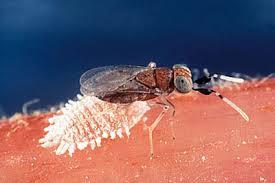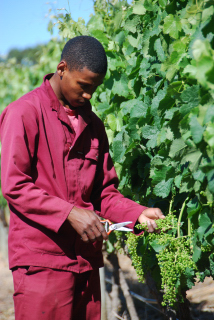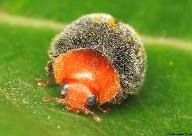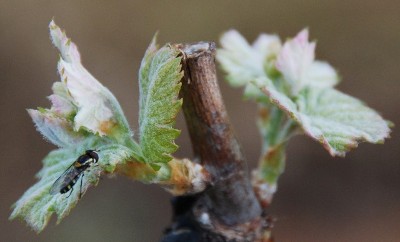Vintage report 2016
Click here for our current vintage report!
2002 2003 2004 2005 2006 2007 2008 2009 2010 2011 2012 2013 2014 2015 2016 2017 2018 2019 2020 2021 2022 2023 2024
Merlot 2016
Given that the previous vintage was already dry, the 2015-16 season
was even worse. Even during winter, we had far too little rain, and
temperatures were too warm. Budding happened accordingly early, and the
continual warm and very dry weather throughout the season produced an
equally early harvest.
But similar to the previous year, the grapes ripened very evenly and
were, above all, very healthy. We harvested eventually the grapes for
the red wines all at the same time, and virtually nothing had to be
sorted out. This years fruit was really of top quality, with loose
clusters and small, firm berries, producing exciting wines in the
cellar.
As quality and quantity were right this year, we were able to select
generously and could once again produce the full range of our
wines, including the Merlot forte. As is our tradition, this vintage has been supplemented with a
dash of another Bordeaux grape, this year with Petit Verdot,
which we could snatch from a neighbor in excellent quality.
It was also the first time that we played around with longer barrel maturation,
thanks to the strong structure of
this year's wines. Though we bottled the Little Merlot as usual after 10
months of barrel maturation, we allowed our flagship wine, the Bein
Merlot, 14 months in barrel. And the Reserve Merlot was even matured for
22 month in 100% new French oak barrels.
Last but not least, we produced a Merlot Forte again, after the first
edition was snatched up by our customers within 1 months after release.
This wine naturally matures for two years in barrel, and you can look
forward to get it in 2018.
- Bein Merlot 2016: after a slightly longer
maturation of 14 months in French barriques
(30% new), this wine was bottled end of May 2017 and then allowed
another year of bottle maturation until its release mid 2018. The
vintage 2016 produced dense and compact wines with
particularly good colour and big tannins. Complemented with a dash
of Petit Verdot from neighboring vineyards. It was bottled in June
2017.
Tasting notes May 2018: Although still young, this wine impresses with fine fruit of dark berries and cherries and well integrated barrel flavors, and on the palate with a dense structure and loads of ripe tannins. This wine will need time, but will develop beautifully over the next ten years and above.
Total production 7070 x 0.75L Bottles, Alc 14.5
Alc 14.5 %Vol, Extract 32.5 g/L, RS 2.0 g/L, TA 5.5 g/L, pH 3.69
- Merlot Reserve 2016: Complemented with a dash
of Petit Verdot from neighboring vineyards, this vintage was
matured for 22 months in 100% new oak barrels from top French
coopers, resulting in a very complex wine with a particularly strong
character, rich and full-bodied, a gorgeous wine with lots of ripe
tannins and savory aromas. Great aging potential, possibly best in
2020-2030. .
Serve at 18ºC, open at least one hour before or decant; best as companion to a gourmet dinner, or simply enjoy on its own when mature.
Bottled on 31st of January 2018, 1800 bottles produced
Alc. 14.9, Extract 33.1g/l, RS 2.0g/l,TA 5.6g/l, pH 3.62 - Little Merlot 2016 is as always vinified
from grapes from the more vigorous zones of our vineyard, as defined
by Precision Viticulture. It shows the typical strong character of
this year's wines, but at the same time convinces with ripe tannins
and fine aromas of raspberry and sour cherry. After 10 month
maturation in 3-4-year-old barrels, it was slightly fined (vegan
friendly!) before bottling. A total of 4927 bottles were produced
from this vintage.
Alc 14.5%, RS 3.9 g/l, TA 5.6 g/l, pH 3.64 - Pink Merlot 2016: Harvested on 16 February -
the earliest ever on our farm - the fruit was swiftly destemmed and
macerated for one day on the skins, then gently pressed in our
traditional basket and eventually slowly cold-fermented in stainless
steel. Like every year, this Rosé convinces with its attractive bold
color, the perfect sweet-sour balance and its delicate
aromas of red berries.
2990 x 0.75Lt bottles were produced from this vintage.
Alc 13.47%, RS 4.0 g/l, TA 4.86 g/l, pH 3.37 - Merlot forte 2016: Made from partly dried
grapes and barrel-matured for 30 months on French oak barriques,
this wine is defined by concentrated fruit, a full body and firm
structure, finishing with a lingering
aftertaste. As our chef taster (Leanie L.) puts it: "Plums, prunes,
caramelized sugar and sweet tobacco aromas. On the palate good
sweetness, balancing well with acidity and prominent tannins,
grippy, medium smoothness with lots of fruit on the palate.
Beautiful wine!"
- Production: 1210x0.375ml
- Alc. 16%, Extract 42.3 g/l, RS 9 g/l,TA 5.56g/l, pH 3.5
Vintage Report 2016
Post-harvest 2016 : winemaking
The period after harvest is the actual "winemaking"
challenge. During the first few weeks, the fermentation requires
a lot of attention, with several daily checks, pump-overs, punch-downs,
aeration and other things. Then the pressing, the malo-lactic
fermentation, the racking and barreling ... and last but not least the
finishing and bottling of last year's wine. This is a busy time,
especially as we do this all in pure artisanal style.
In return, the current vintages reward us with an extraordinary quality.
So good, that at last, we can produce again a Merlot Reserve from the
2015 vintage, beside our
flagship wine Bein Merlot. There is, however, bad news for our Little-Merlot-lovers: there will be no Little 2015 :-/
March 1 & 2, 2016: A fantastic crop!
The already early budding and continuously hot and very dry
weather during the season resulted in a correspondingly early ripening,
and the harvest for our main crop started with the first day of March.
Similar to last year, the grapes ripened very evenly and were above all
very healthy, so that we could harvested everything over two days, and
little had to be sorted out. The comparably loose clusters with their
small, firm and deep-dark berries promise a great quality for our future
2016 wines.
Weather-wise, the first autumnal rain at the end of March brought finally
some relief for the stressed nature. Let's hope that El Nino will now
release us from his grip and the drought is soon over.
16 February, 2016: An early harvest
February's weather was still unusually dry and very warm, which
significantly advanced the harvesting season. So we started already on 16 February with the harvest of the
grapes for our rosé. As always, the wine is then slowly cold-fermented
at 15°C for optimal flavor development. Together with this years
typically lower acidity - caused by the hot ripening season - this will
become a very palatable rosé, to which we look forward to sell :-)
Fortunately, the second half of the month was somewhat cooler,
especially at night, though it’s still very dry and sunny. Nevertheless,
these are perfect ripening conditions for the grapes for the red wine,
so we are looking forward to a good harvest for our Bein Merlot.
January 2016: hot and dry!
With the New year, yet another heat wave started, which seems to be
determined to persist
throughout the entire month. It is really unusually hot, with regular
midday-temperatures of 32-35 degrees. And it is dry, really very dry! In
fact, South Africa is in the grip of its worst drought in decades. The
meteorologists say that 2015 was the driest year on record, which dates
back to 1904. And it shows no sign of abating....
![]() Together
with the start of the New year, also our Merlot started changing color, a bit
earlier than usual. And we started to post photos on Instagram, so you can follow us now on
instagram
#beinwine to view pictures of how our new vintage develops.
Together
with the start of the New year, also our Merlot started changing color, a bit
earlier than usual. And we started to post photos on Instagram, so you can follow us now on
instagram
#beinwine to view pictures of how our new vintage develops.
December 2015: It's time for the air force!
December started with a
week-long heat wave, with temperatures up to 36 degrees. Luckily, the
rest of the month was more moderate, and we even had some rain of 19 mm
during mid December.
Unfortunately, these dry
conditions are ideal for our enemies, the mealybugs (see our October post). So
it’s time for an "air strike".
 With
this, we mean another augmentive release of natural antagonists, namely tiny little wasps,
which parasitize the adult mealybugs by laying eggs in it. The hatching
larvae, naturally destroying the bug by feeding on it, develop within
10-14 days into adult wasps, which in turn take on the next generation
of mealybugs. The picture shows such a beneficial wasp (Anagyrus
pseudococci) at oviposition.
With
this, we mean another augmentive release of natural antagonists, namely tiny little wasps,
which parasitize the adult mealybugs by laying eggs in it. The hatching
larvae, naturally destroying the bug by feeding on it, develop within
10-14 days into adult wasps, which in turn take on the next generation
of mealybugs. The picture shows such a beneficial wasp (Anagyrus
pseudococci) at oviposition.
November 2015: Lot's of work in the vineyard


October 2015: Biologic pest control
 Beneficial
organisms are the best pest control agents. We favor already long the
development of natural enemies of pests in our vineyard. This year we
went one step further by releasing repeatedly large numbers of tiny parasitic wasps and Ladybugs (see picture), which are specialized on
vine mealybugs (Planococcus ficus). Mealybugs can cause particular damage
by transmitting viruses associated with Grapevine Leaf-roll disease (GLRaV),
a disease that causes substantial economic damage in SA vineyards.
Fortunately, our vineyard is virtually free, since we sanitized it some
ten years ago. So their control is of particular importance for us.
Beneficial
organisms are the best pest control agents. We favor already long the
development of natural enemies of pests in our vineyard. This year we
went one step further by releasing repeatedly large numbers of tiny parasitic wasps and Ladybugs (see picture), which are specialized on
vine mealybugs (Planococcus ficus). Mealybugs can cause particular damage
by transmitting viruses associated with Grapevine Leaf-roll disease (GLRaV),
a disease that causes substantial economic damage in SA vineyards.
Fortunately, our vineyard is virtually free, since we sanitized it some
ten years ago. So their control is of particular importance for us.
September 2015: An early spring

Budding was early this year, as shown on this picture of 8 September
2015. By the way, that
little insect on it is a hoverfly, a beneficial insect, whose
larvae are natural enemies of aphids. Read more
about natural enemies of pests and how we make use of them here later in
this year.
June - August 2015 : Winter time!
After the last season was characterized by persistently warm and
particularly dry weather, this winter brought only little rain, too. By
now, most dams of
Western Cape are still less than three quarter filled (dam
levels of Western Cape).
Temperatures, however, were sufficiently low for a good winter rest of
the vines. Nevertheless, we also had a lot of warm, sunny days, and we
could observe the first signs of budding, so called bud swell, already
towards the end of August, 2 weeks earlier than usual.
During winter, we are of course not only busy with the traditional
winter work in the vineyard, above all of course, pruning the vines, but
we are quite active in the cellar, too. The reds of this year, which are
in barrel since March, had quickly completed malolactic
fermentation and needed a first racking. Also our Pink Merlot 2015 had
to be finalized and bottled. It come out well, convincing as ever with
its beautiful bright color and fine aromas of red berries.
Last but not least, we bottled last year's Red. Like every year, it took us
many blind tastings and even more discussions, until we chose to
supplement our Merlot 2014 with a dash of Cabernet Sauvignon and Malbec
each. But the good results let us forget the hassles of the difficult
harvest 2014; the wines surprise with pure, fine aromas and particularly
smooth tannins. Again, two qualities could have been bottled: The Little
Merlot from the 3rd and 4th fill barrels, which is as always more fruit driven
and earlier accessible und thus available since July; and
the Bein Merlot, which was matured in mainly new oak barrels and
therefore will first
be allowed some more time of bottle maturation before its release.

